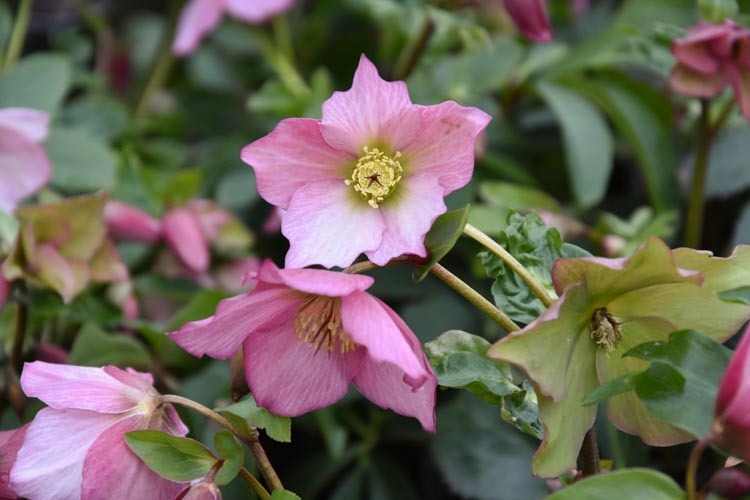A true harbinger of spring in Ontario are the hardy and ethereal hellebores, often found in full bloom underneath a blanket of snow in early spring, even before the snowdrops and crocus and daffodils begin to emerge.
In almost dreamlike fashion, hellebores offer a pop of colour and loads of intrigue against a mundane and neutral landscape. They are a most welcome sight to winter-weary gardeners!
Hailing from the Ranunculaceae (buttercup) family, hellebores resemble a cross between buttercups and roses. (Unlike roses, they are largely blessed with no serious insect or disease problems.).
They are available in a myriad of colours and shades – ranging from bold, mystical deep purple to more subtle, captivating shades and tints of white, pink, red, yellow, and green.
Hellebores are hardy, low-maintenance plants to enjoy in multiple seasons – no shrinking violets here! They produce bushy clumps of thick, leathery evergreen leaves in late winter, 12-15” in height, before flower stalks appear in early spring bearing showy cup-shaped blooms, 2-3” in diameter.
They seem to prosper in cold temperatures, under snow-cover and frost, perking up when warmed by the sun. Blooms continue for weeks, sometimes months, with active growth in both spring and fall. During summer’s hot spells, hellebores stop growing until cooler weather arrives.
The two main species are Helleborus Niger (‘Christmas rose’) and H. orientalis (‘Lenten rose’); hybrids come in over a dozen unique and interesting varieties that should suit anyone’s plant palette.
Hellebores are one of the best perennials for shade, tolerant of most light and soil conditions, low-maintenance, long-lived, long-blooming, evergreen, virtually disease-free, and deer proof.
Hellebores are widely available in the spring, with best prices and selection at this time of year –and it’s also the best time to plant them. If you’ve picked one up as a houseplant at a recent show or sale, enjoy it now and then plant it outside after risk of frost has passed. The hardest part will be choosing which one(s)!
Suggested Uses
It’s best to plant hellebores where you are able to enjoy them – near windows, patios or walkways. Group in shady locations under trees, large shrubs or in woodland gardens. They may also be incorporated into a naturalized area where the clumps will slowly spread through self-seeding and mass for an attractive year round ground cover.
Preferences + Tolerances
- Prefers slightly neutral to acidic soils, organically-rich, fertile, and well-drained with medium moisture
- Prefers light- to moderate-shade, but can tolerate almost full-sun and almost full-shade. More light = more blooms
- Water regularly until established; hellebores don’t like to dry out. Once established, they may be able to tolerate drier conditions
- Dislike disturbance – avoid moving or dividing mature plants, if possible
- Shield plants from extreme winter conditions/winds to prevent damage to prized evergreen foliage and ensure plants are insulated by snow cover
Pests or diseases
Crown rot and leaf spot are occasional problems that may occur if planted in heavy shade and moist soils with poor drainage – in which case, relocate! Green aphids can also be a problem – spray foliage with a hose to remove, or treat with insecticidal soap, as needed.
CAUTION!
Hellebores are harmful if eaten. Skin irritant. All parts of the plant are poisonous.
Hellebores’ genus name comes from the Greek words bora, meaning food, and helein, meaning injures/destroys in reference to the plant’s toxic leaves, stems and roots which are poisonous to humans if ingested.
Notable Varieties
Helleborus ‘Rosemary’ – Lenten rose (Helleborus x hybridus) and Christmas rose (H. niger) cross – rare and widely considered as one of the best hellebores of all time. Features unique pale pink flowers with faint striping; flowers darken with age (light salmon tones through to deep rich salmon colours). Blooms for 3+ months (after Christmas roses, but up to one month before Lenten roses)

Photo credit: https://www.gardenia.net/plant/Helleborus-Walbertons-Rosemary-Christmas-Rose
Helleborus ‘Anna’s Red’ and ‘Penny’s Pink’ – Bred by Rodney Davey and named after plantswoman Anna Pavord, it took 12 years to breed a red hellebore with marbled leaves. Features stunning red and pink flowers with mottled foliage that emerges variegated with red and pink, before fading to mint green mottling on a dark green leaf

Photo credit: https://www.gardenia.net/plant/Helleborus-Annas-Red
Heleborus niger ‘Christmas rose’ is the most well-known hellebore, one of the first to bloom, sometimes with early snowdrops. Features snow-white flowers; hardy down to zone 4
Heleborus torquatus – a collector’s favourite with interesting foliage; rare; slightly more difficult to grow
Where to Buy Hellebores
- Online: Phoenix Perennials – Richmond, B.C.-based nursery and mail-order company that ships 63 varieties of hellebores across Canada
- Canada Blooms, various garden shows and sales
- Check stock with your favourite nursery
By Barb McKechnie, GWMG in training
